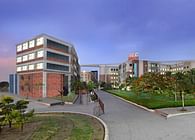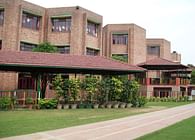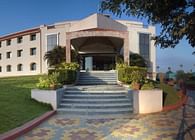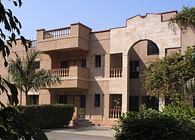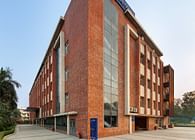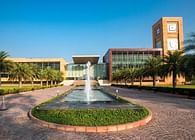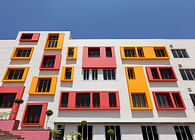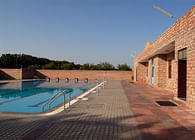
New Delhi, IN
Schools today must cater not just to learning and functional requirements, but inculcate a sense of exploration and community-building, enabling creative expression in children, especially relevant today when children are prone to spending more time by themselves on screens rather than outside. Balancing these multifarious spatial requirements becomes a challenge in dense urban settings with tight site constraints, but can be achieved through an optimised program that prioritises flexibility of spatial use. In this way, Amity Global School in Gurugram navigates its site constraints with a rich programmatic blend centred around a triple-height atrium.
Zoning the school around its heart – the atrium
The campus, with a 1-acre site, adopts an introverted zoning scheme to cater to the diverse demands of its curriculum. The programme brief stipulated for 20 students per class required participatory spaces that would enable hands-on activities, group projects and discussions among the children. The design also included a large auditorium, multiple activity rooms, and play areas for all age groups, adding to the community spaces in the programme. Tying all these functions together is the triple-height atrium, placed at the core of the school building – which all corridors, classrooms and activity rooms look into. The voluminous space with a concave profile extends into the basement, rising to meet the entrance porch, thus creating a welcoming vista for all students and visitors alike. Because of its centralized planning, the atrium acts as an informal congregational point at all hours of the day – whether as an assembly space for the whole school, spill-over for activity areas in the semi-basement level, or as a waiting area for pick-up and drop-off.
Apart from its social function, the atrium fitted with a translucent tensile roof enables natural daylight filtration within the building, eliminating the need for mechanical lighting.
Creating Sightlines to Foster Connection
The design of the school is a fine balance between allowing freedom for exploration and ensuring security for its children – two major requirements of an educational environment – by adopting strategies that establish visual connections within the built volume. In this regard, the central atrium acts as the social as well as visual core of the school – with all the zones opening into or overlooking the open volume. A glazed profile for the administrative zone allows the principal and support staff to monitor school activities from within their offices. The tectonic layout of the school also provides visual cues for user movement, familiarizing visitors with the building layout from the atrium itself. In this manner, users can view activities happening within the school from multiple vantage points, fostering a greater sense of community and comfort.
Maintaining this philosophy of openness and interconnection, each classroom features clerestory windows and glass-panelled doors, with colourful portholes along corridor walls through which students can observe the activities happening in the rest of the school from the safety of their respective classrooms.
Enabling Students’ Creativity in Interior Spaces
The primary focus for the interior scheme was user engagement, which led to a close collaboration with the teaching staff. Every classroom has been designed as a self-contained unit that can adapt to the needs of its users with modular furniture for flexibility of function. The interiors are manifested in muted tones of ivory and wooden finishes providing a foil for students’ artworks and project displays. Through this, the architecture itself comes alive, changing with a change in the batch of students.
A utilitarian approach means that the rooms are equipped with AV equipment, acoustical treatment, manually operable louvres and blinds to modulate ingress of sunlight, and ample storage space. This approach also manifests in the colour and material palette, where waste stone from construction was upcycled, and used for the basement flooring. This helped eliminate material wastage to a high degree, bringing down project costs.
Optimizing available resources in a dense urban setting, Amity Global School’s design presents one solution to providing world-class facilities, all the while keeping in mind the social needs of its users and the limitations posed by climate and context.
Status: Built
Location: Gurgaon, IN
Firm Role: Architects
